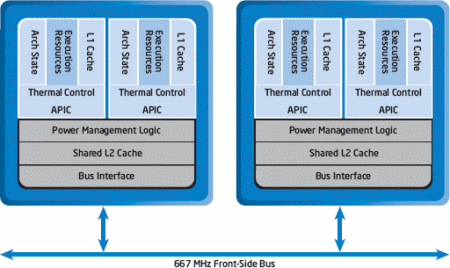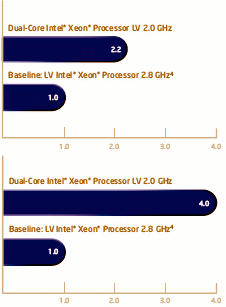New low-voltage, dual-core Xeon gains Carrier Grade Linux
Mar 14, 2006 — by LinuxDevices Staff — from the LinuxDevices Archive — 4 viewsWind River says its commercial embedded Linux implementation for networking applications supports a low-voltage, dual-core Xeon processor shipped today by Intel. Wind River's Platform for Network Equipment (PNE), Linux Edition, is available now with “architecture support” for Intel's Dual-Core Xeon LV, it says. Both products target telecommunications and enterprise networking.
Dual-core Intel Xeon LV processors
Intel's new dual-core Xeon LV chips target low-power communications and embedded applications, including storage area networks (SAN), network attached storage (NAS), routers, virtual private networks (VPN), firewalls, intrusion detection systems, and telecommunications (wireless and wireline) servers, “particularly in AdvancedTCA form-factor designs,” Intel says.
The Xeon LV chips are built on 65-nanometer process technology, and integrate a pair of x86 cores clocked at either 1.6GHz or 2.0GHz for now, along with 2MB of L2 cache. The two cores are linked by the same 667MHz FSB (frontside bus) that interfaces with supported chipsets, such as Intel's E7520. The chips are software-compatible with existing x86 applications, Intel says.

Xeon LV architecture diagram
The Dual-core Xeon LV chips integrate advanced “Speedstep” power management hardware aimed at scaling both CPU frequency and voltage in response to processing demands. At 2GHz, the Xeon LV has a claimed TDP (thermal design power, or “total dissipated power” in Intel-speak) of 31 Watts. The chips offered two to four-times higher performance-per-Watt than older Xeon chips, in Intel-run benchmarks.
Left: Specint_rate_base2000. Right: Specint_rate_base2000/TDP
(Source: Intel)
Wind River PNE
Wind River's PNE, Linux Edition is based on a Carrier Grade Linux (CGL) distribution built on a 2.6 Linux kernel. It supports the PICMG's ATCA 3.x specification (Advanced Telecommunications Computing Architecture) and targets new networking applications, including wireless infrastructure, IP telephony, and enterprise networking. Additionally, it supports a variety of high-availability features, and features a standards-based IPC (inter-process communication) mechanism that allows it to interoperate with the VxWorks-based version of PNE, Wind River says.
Ton Steenman, GM of Intel's Infrastructure Processor Division, stated, “Availability of out-of-the box, dual-core ready software, like the Wind River Linux-based device software platform, means our customers can speed development of higher performing networking solutions based on industry standards such as AdvancedTCA and Carrier-Grade Linux.”
Availability
The Dual-core Xeon LV chips are available now, with 1.66GHz and 2.0 GHz parts priced at $209 and $423, respectively, in 1,000-unit quantities, and packaged in a 478-pin micro-FC-PGA.
 Additionally, Intel plans to ship several boards based on the Dual-core Xeon LV this spring, including:
Additionally, Intel plans to ship several boards based on the Dual-core Xeon LV this spring, including:
- A $4,495 NetStructure MPCBL0040 ATCA blade (pictured at right) targeting high-density computing applications, such as IMS (IP Multimedia Subsystems, or Services, as Intel calls them), IPTVs (Internet Protocol TVs), and wireless control plane applications
- An SBXD62 Server Compute Blade SBXD62 priced at $945, without processor, heat sink, memory, or hard drive
Additional details about the new Intel dual-core Xeon chips can be found here.
Wind River's PNE, Linux Edition, is available now with “architecture support” for the Intel Dual Core Xeon LV 2GHz, Wind River says. Presumably, it supports the 1.66GHz part as well.
Additionally, Wind River now offers a “Network Infrastructure Services Practice,” an outsourcing and consulting service that offers “device design, network management and security, network compliance testing, wireless networking support, layer 2 Ethernet switching, BSP/LSP and device driver optimization, legacy application and infrastructure migration, Linux migration, and real-time best practices,” Wind River says.
Platform for Network Equipment (PNE) was Wind River's first Linux-based software stack. It first shipped on Valentine's Day, 2005, and was updated last June.
This article was originally published on LinuxDevices.com and has been donated to the open source community by QuinStreet Inc. Please visit LinuxToday.com for up-to-date news and articles about Linux and open source.
